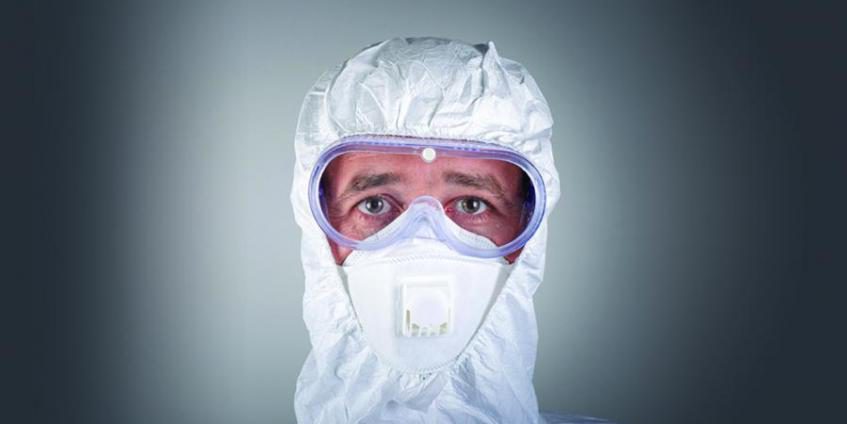Introduction
During the research and development (R&D) of new and novel energetic materials, researchers face a myriad of technical and safety challenges in the laboratory that need to be addressed and overcome. The extremely volatile nature of energetics requires particular attention and vigilance. While the exact number of accidents resulting in injury or death is not easily obtained, the Chemical Safety Board—an independent federal agency charged with investigating industrial chemical accidents—has gathered preliminary information on 120 university laboratory accidents since 2001 that have resulted in 87 evacuations, 96 injuries, and 3 deaths [1].
This article discusses the challenges of working with energetic materials in the laboratory and provides guidance on process development and safety
equipment that can be used to reduce the associated risks.
Whether it be from the toxic precursors or the sensitivity of the synthesized energetic, energetic materials safety requires a multi-pronged approach that begins with defining the task to be performed and developing a project plan. The inherent danger of working with energetic materials in the laboratory requires the researcher to develop a comprehensive safety plan and scale-up procedure. While accidents are not common, when they do occur, they result in significant injury, often to the hands and arms, which are typically most at risk due to the close proximity to the energetic material.
Hazardous chemicals can present both physical and health threats. Chemicals encountered during the development phase may include carcinogens; toxins that may affect the liver, kidney, or nervous system; irritants; corrosives; and sensitizers; as well as agents that act on the blood system or damage the lungs, skin, eyes, or mucous membranes. In addition to the health threats posed by the hazardous chemicals present in the laboratory, working with materials having the potential to form explosive mixtures or compounds requires special precautions, as some explosives are sensitive to small amounts of stimuli in the form of friction; impact or shock; electrostatic discharge (ESD); or heat.
Process Development
Key to any project involving explosives is a well-thought-out process that requires critical thinking before, during, and after the project for continuous safety in any laboratory. First, it is important to identify hazards and implement controls to address those hazards before beginning a project. Then, during project execution, the effectiveness of the controls should be constantly evaluated, and any adjustments should be made and captured as modifications to the operating procedures governing the operation. And once the work is complete (as well as during the project), all unusual incidents, mishaps, or unexpected chemical reactions should be captured and kept within a laboratory central repository for others to access. This repository can serve as a “lessons learned” library and should be consulted prior to the start of any new activities. Adjustments to procedures should be made as needed to accommodate for any possible hazards associated with the material.
Figure 1 illustrates the steps for developing a comprehensive safety program when working with energetic materials. Safety program development starts by defining the task, including each interim step and the identified hazards, and concludes with the execution of work and the associated
lessons learned [2].

Figure 1: Steps in Developing a Comprehensive Safety Program.
Hierarchy of Hazard Controls
Safety is the responsibility of personnel within all levels of an organization involved in energetic materials R&D. From the laboratory personnel to the facility manager, these personnel are responsible for conducting thorough procedural safety reviews (internal to their organization and/or through technical community peers) before commencing synthesis or formulation operations.
Each level of an organization carries responsibilities and implements corresponding controls to assist with those responsibilities. The concept of the Hierarchy of Controls described in the Laboratory Standard, 29 C.F.R. § 1910.1450, prioritizes intervention strategies based on the premise that the best way to control a hazard is to systematically remove it from the workplace, rather than relying on employees to reduce individual exposure [1]. As indicated in Table 1, the four types of measures that may be used to protect employees (listed in decreasing order of effectiveness) are (1) elimination or substitution, (2) engineering controls, (3) administrative controls, and (4) personal protective equipment (PPE).
|
HIERARCHY OF HAZARD CONTROLS |
||
|
LEAST EFFECTIVE |
Control |
Examples |
|
|
|
|
|
|
|
|
|
|
|
|
Elimination or substitution of hazards can be accomplished by modification of existing equipment and material acquisition programs. Engineering controls, such as chemical hoods, physically separate the employee from the hazard. Administrative controls, such as employee scheduling, and development of standard operating procedures (SOPs), are established by management to help minimize the employees’ exposure time to hazardous chemicals. Finally, protective clothing and PPE are additional protection provided under special circumstances and when exposure is unavoidable.
Protecting Personnel
The key hazards posed by an initiating explosive are noise, fragments, blast, and heat. There are also secondary effects, such as the ignition of nearby flammable materials, the formation and release of harmful gases, and chemical contamination.
Note that elimination or substitution (use of an analog), while most effective at reducing hazards, also tends to be the most difficult measure to implement. Furthermore, the use of engineering controls is usually the most effective way to protect all laboratory workers because these measures make changes at the source of the hazards and do not rely on the skill or vigilance of individuals. The basic concept behind engineering controls is that, to the extent feasible, the work environment and the task itself should be designed to eliminate hazards or reduce exposure to hazards.
Title 29 of the Code of Federal Regulations, specifically C.F.R. § 1910.132, requires employers to ensure that PPE be provided, used, and maintained in a sanitary and reliable condition to prevent injury. Unfortunately, choosing the proper PPE can often be challenging as most equipment is not tested against the effects of an unintended initiation that can result in fragmentation hazards and blast overpressures.
Protective Shields
Engineering controls such as a blast shields can minimize the risk to personnel by protecting personnel from the resulting blast effects from an unintended initiation. Military Standard (MIL-STD) 398A [3] specifies that shields shall be designed to prevent exposure of operating personnel to peak positive incident pressures greater than 2.3 psi (15.9 kPa), which is below the threshold for a disabling injury, and heat flux should be limited to prevent the onset of second-degree burns.
The U.S. Naval Surface Warfare Center at Indian Head, MD, conducted testing looking at the blast overpressures and heat flux imparted on both standing and sitting operators resulting from the detonation of ~2.6 g and ~11.5 g of PBXN-5 pellets using Reynolds RP-80 detonators containing 0.2 g of explosive. Test results showed that properly designed shields provide adequate protection against blast over pressures and heat flux [4]. The U.S. Department of Energy (DOE) Explosives Safety Manual (DOE M 441.1-1A) lists shields that have been tested and found acceptable for the indicated quantities of explosives [5].
In addition to the testing conducted by the DOE, the Atomic Weapons Establishment (AWE) tested a number of commercially available safety shields to assess the level of protection provided [3]. The shields were tested against detonating charge masses of 0.3 g, 1 g, 5 g, and 7.5 g for PETN-based explosives, and 1.3 g for an HMX-based explosive. The fragment sources used in the trials were Glass Round Bottom Flask (RBF), Porcelain Buchner Funnel (BF), or Glass Test Tube (TT). Complete details on charge selection, composition, and test configurations can be found in DOE M 441.1-1A [5].
PPE
Physical hazards encountered while working with energetic materials pose a significant challenge in the implementation of PPE. The selected PPE must provide adequate protection while also not excessively inhibiting dexterity and grip, which could introduce additional hazards. Using PPE requires hazard awareness and training on the part of the user. Users must be aware that the equipment does not eliminate the hazard. If the equipment fails, exposure may occur. Thus, when selecting the proper PPE, employers and employees must understand the equipment’s purpose and its limitations.
As mentioned, the hands and arms are typically most at risk when working with energetic materials in the laboratory due to the close proximity to the material being manipulated. Hand and arm injuries can result in a permanent loss of motoric function. To help mitigate these injuries, protective equipment includes gloves, finger guards, and arm coverings or elbow-length gloves. Tests conducted at AWE have shown as little as 0.3 g of PETN-Sylgard 182 explosive paste is capable of causing significant injury at small standoff distances when surrounded by a suitable fragment source [6].
Hand and arm protective wear is evaluated on its ability to provide protection from mechanical damage, including punctures, cuts, abrasions, fractures, and amputations, as well as protection against heat and chemical contamination. Unfortunately, the current standards for testing against mechanical damage, EN 388 and ANSI/ISEE 105, are not representative of the hazards posed by a small-scale explosive event and therefore do not accurately represent the threat. Klapötke et al. [8] and Murray et al. [7] tested a variety of gloves and wrist and arm protectors to assess the level of protection offered by various materials, as well as limits on motoric function. Complete details on glove selection and test results are provided in these references [7,8].
Conclusion
The development of energetic materials can be a risky endeavor. Whether they be in an academic setting, National laboratory, or a Defense facility, researchers and laboratory personnel need to ensure proper measures are in place to manage the risks. Having a detailed plan listing each step and the associated hazards is important to ensure the safety of personnel. While the literature offers some guidance on the selection of safety equipment, it also shows a gap in test standards and the addressing/mitigation of hazards encountered in the energetics laboratory. Accordingly, efforts are needed to close this gap and further protect personnel working in this area. While federal, state, and local regulations should be consulted and followed, it is also important to conduct an independent assessment of the project being performed, the hazards associated with the chemicals involved, and the environment that the project is being conducted. This assessment will aid in the identification of potential hazards and allow for safety measures to be put in place to mitigate these hazards. And as always, caution and knowledge will continue to be the keys to safe work practices when handling energetics.
Note
The research in this area was accomplished in tandem with a federally sponsored Chemical Propulsion Information Analysis Center (CPIAC) project on the collection of standards and best practices for safely handling improvised and homemade explosives.
References:
- National Research Council. “National Research Council Recommendations Concerning Chemical Hygiene in Laboratories.” 29 C.F.R. § 1910.1450, 2015.
- Pantoya, M., and J. Maienschein. “Safety in Energetic Materials Research and Development – Approaches in Academia and a National Laboratory.” Propellants, Explosives, Pyrotechnics, vol. 39, pp. 483–485, 2014.
- Department of Defense. “Department of Defense Design Criteria Standard, Shields, Operational for Ammunition Operations.” MIL-STD-398A, January 2014.
- Sandusky, H. W., and V.D. Moore. “Effectiveness of Transparent Shields in Protecting Explosive Operations Personnel.” Naval Surface Warfare Center, Indian Head, MD, 1994.
- U.S. Department of Energy, Office of Environment, Safety and Health. “DOE Explosives Safety Manual.” DOE M 441.1-1A, September 2006.
- Murray, C., et al. “Protective Equipment for Small-Scale Laboratory Explosive Hazards. Part 2. Shielding Materials, Eye and Face Protection.” Journal of Chemical Health and Safety, http://dx.doi.org/10.1016/j.jchas.2014.11.004, 2015.
- Murray, C., et al. “Protective Equipment for Small-Scale Laboratory Explosive Hazards. Part 1. Clothing for Hand and Body Protection.” Journal of Chemical Health and Safety, http://dx.doi.org/10.1016/j.jchas.2014.08.001, 2014.
- Klapötke, et al. “Hands on Explosives: Safety Testing of Protective Measures.” Journal of Safety Science, http://dx.doi.org/10.1016/j.ssci.2009.05.002, 2010.



